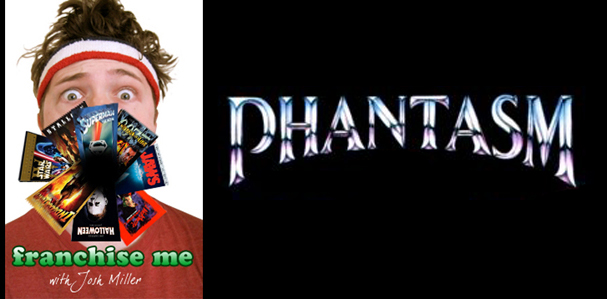
Hollywood loves a good franchise. The movie-going public does too. Horror, action, comedy, sci-fi, western, no genre is safe. And any film, no matter how seemingly stand-alone, conclusive, or inappropriate to sequel, could generate an expansive franchise. They are legion. We are surrounded. But a champion has risen from the rabble to defend us. Me. I have donned my sweats and taken up cinema’s gauntlet. Don’t try this at home. I am a professional.
Let’s be buddies on the Facebookz!
The Franchise: Phantasm — following the escalating menace of the Tall Man, a supernatural undertaker from another world who steals human corpses in order to turn them into zombified dwarfs, and his battles with his greatest foe, Reggie, a bald pony-tailed guitar-playing ex-ice cream man.
previous installments
Phantasm
Phantasm II
Phantasm III: Lord of the Dead
The Installment: Phantasm IV: Oblivion (1998)
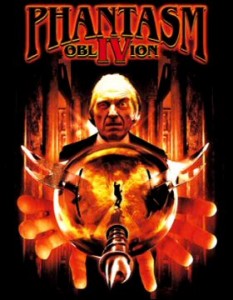
The Story: As always, we open with a “Previously on Phantasm” narrated recap montage, but for the first time ever there is no retconning! Remember how at the end of the previous film Tim was pulled through a window into a black void by one of the Tall Man’s minions? Well… he’s not around anymore, so I guess for once that actually happened! Last we saw Reggie he was pinned to a wall by a horde of spheres. Somewhat inexplicably, the Tall Man decides to let Reggie go. So Reggie hits the open road, searching for Mike, who you will recall went off into the night at the end of Phantasm III. On his journey Reggie encounters some minions and crosses paths (of course) with a comely young lass (Heidi Marnhout). Mike’s adventure on the open road is a bit more eventful. Calmly menaced, Bond-villain-style, by the Tall Man, Mike grapples to understand just what the effing eff is going on — with him, with the entire franchise. Mike’s mental powers have increased; now he has powerful telekinesis. He builds his own sphere out of automobile parts. He tries to commit suicide, only to discover that he can’t die. He travels through time and meets the Tall Man back when he was a peaceful and friendly human named Jebediah Morningside. And he does a lot of remembering, utilizing numerous deleted scenes from the original film.
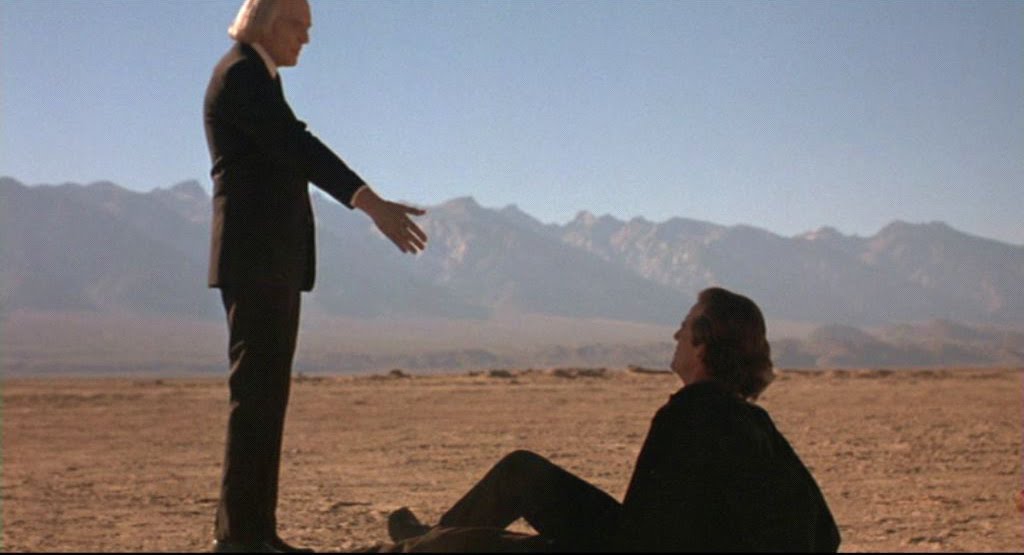
What Works: Phantasm IV: Oblivion – or Phantasm: OblIVion, as the film likes to call itself, or Phantasm: Oblfourion, as I like to call it – is easily the most divisive film in the series; a Love-It-or-Hate-It installment. It certainly would have been preferable to end the series with a film that all Phantasm fans universally adored, but it is fitting that the franchise at least ended in a really bizarre fashion, and not simply with a middling entry rehashing popular bits. Objectively, a lot of what “works” also qualifies as what “doesn’t work” here, so I will fairly address the film as such.
Over-shooting Phantasm turned out to be quite a boon for Don Coscarelli. Not only did cutting down his monstrous horror epic to a reasonable length enhance its impressionist and nightmare-like qualities, but all those deleted scenes wound up coming in pretty handy twenty years later. Though very clearly done as a money saving device, Coscarelli’s use of Phantasm “flashbacks” in IV is a surprisingly revolutionary approach to crafting a horror sequel, especially a sequel that wound up being the final film in the series. This gimmick likely could not work in another franchise without leaving a bad sitcom “flashback episode” taste in fans’ mouths. Howling VII: New Moon Rising tried something similar and it was obnoxious and boring. In IV, the fact that we’re dealing with an impressive amount of previously unused footage is part of what allows the gimmick to work, but more importantly is how effortlessly the flashbacks fit into the texture of the franchise.
Coscarelli has gone on the record noting that he feared he’d gone too far into horror-comedy with III, so IV was meant to be a return to form. In this sense, IV is truest sequel to Phantasm. While it lacks the youthful zeal of the original film, it is able to capture some of its magic simply by repurposing these surplus chunks. These flashbacks don’t always add up to anything, but they’re entertaining in the way that deleted scenes often are. And at times they really do add to the film. Most effective are a pair of Reggie/Mike scenes that Coscarelli uses to begin and then end the film (and franchise) with. The first scene features Mike playfully hopping on the back of Reg’s ice cream truck; the final scene features Mike and Reggie eerily riding through the calm of the night together in the truck. Reggie asks, “Did you hear something?” To which Mike responds strangely, “It’s just the wind. Only the wind.” What works so great with this is that it is hard to imagine exactly what context this final scene had in the original film, so it feels like something written for IV, only starring A. Michael Baldwin and Reggie Bannister circa 1979.
Inversely, the one contemporaneously shot flashback, featuring the actors from 1998 pretending they’re in 1979, sticks out like a charmingly sore thumb.
My favorite flashback is more interesting than it is good. The scene features a truly mystifying plan to defeat the Tall Man on the part of Jody and Mike. During the chase, Mike and Jody somehow get the Tall Man to run head first into a noose, and then promptly string him up from a tree. Then they just leave! Mike ends up wandering back later and the Tall Man “convinces” Mike to let him down. This scene was very wisely removed from the original film if for no other reason than it makes Mike seem impossibly stupid. This is the brilliant verbal exchange the Tall Man uses to trick Mike:
Tall Man: Cut me down!
Mike: No!
Tall Man: I won’t hurt you.
Mike: You’re killing the world!
Tall Man: I’ll go away… and I won’t ever come back.
Mike: You will?
Tall Man: Yes.
He’s like Hannibal Lector, this Tall Man! But the scene is fun nonetheless, simply because of the awesome performance Angus Scrimm gives. Man, that guy can deliver a line. He’s also a world champion goofy-face-maker.
II was all about the relationship between Reg and Mike. III was all about the spheres. IV is all about the Tall Man. Like Lost, this franchise always seems to introduce two new perplexing elements with every element it pretends to explain. Of course, fans of both series feed off this head-scratching ambiguity (do Phantasm fans call themselves “phans?”). It may actually have been disappointing if suddenly everything were laid neatly out on the table. The single most intriguing revelation of IV is that the Tall Man was once a quaint 19th-century (I’m guessing) inventor. When Mike walks through the portal forks, he comes out in the laboratory of Dr. Jebediah Morningside, where a steam punk version of the portal exists. It is delightful to watch Angus Scrimm drop his squint and his Tall Man delivery for Morningside, offering Mike some lemonade before realizing that Mike must have come through the fork. The most information we’re given on how exactly Dr. Morningside became the Tall Man happens when Jody-sphere shows Mike the moment when Morningside first entered the portal, only to return seconds later as the Tall Man. “Jebediah Morningside never did come back,” Jody-sphere tells us. Through extrapolation one could piece together some more backstory here: Morningside created a portal to the Tall Man’s world, and the Tall Man killed Morningside and has used his body to carryout his devious Jawa-creating mission on Earth ever since. Morningside was the name of the cemetery in the first film, so it would also seem that we’re being told that the Tall Man founded or bought that cemetery to aid in his mission. Why it took him an entire century to branch out and post-apoc the rest of the nation, we don’t know. Why he seems to have an unlimited supply of Dr. Morningside bodies to inhabit, we also don’t know. Why is the blind psychic grandma from the first film chilling with Morningside in the past? Is she immortal? Who knows. Such is Phantasm.
I have some issues with the Reggie portions of this film, but first let’s talk about the good shit. Sphere breasts. Though the spheres play a significantly diminished role in IV, compared with the steady expansion the little bastards had seen in each previous installments (in both screentime and mythology), one could say they saved the best for last. We all know that Reggie is going to try and bang Jennifer, the chick he meets after essentially causing her to crash her car while flirting with her on the highway. While pervily ogling her while she sleeps in the bed they’re sharing, Reg notices her breasts are throbbing. Some further pervy investigation leads to the discovery that Jennifer’s boobs are in fact spheres. She asks, “You wanna get it on, Reggie?” To which he responds with a terrified, “No!” Then the spheres pop out of her chest and battle Reg. The other great Reg moment comes during a battle with a zombie cop who has pulled Reg over. Reg climbs into the front of the cop car, trying to retrieve the cop’s shotgun, which is unfortunately locked in place. But Reg, always the resourceful fighter, still makes use of it when the zombie cop climbs onto the roof of the car, allowing Reg to simply fire the gun straight upwards. Last but not least, there is the ice cream man uniform. There isn’t a logical reason why Reg would put that uniform on at the end of the film in order to battle the Tall Man, but it doesn’t matter. It’s fabulous that he does.
A. Michael Baldwin finally reclaims his position as the central figure in a Phantasm film. Baldwin’s moody, dour performance felt at odds with the light tone of III and James LeGros’ adult Mike that we’d just gotten used to in II. But Baldwin suits the tone and material of IV, playing Mike as weary and angry — which seems like a reasonable reaction to living through all this insanity. And obviously the juxtaposition between footage of a teenage Baldwin and adult Baldwin is going to be a trip to watch. Mike’s increased mental powers also offer a bit of novel action for our hero. A scene of Mike wandering amongst the rocks in the desert really takes the Jawa comparisons with the Tall Man’s dwarfs to a new level. As Mike walks along, with Jawas skittering behind rocks, I half expected Mike to suddenly be accompanied by R2-D2. But Mike fares better against the Jawas than the Star Wars droids did, as Mike uses his mind to move a boulder and crush a Jawa, then make an awesomely smug face of satisfaction. Although beefing up the importance of A. Michael Baldwin has an unfortunate side-effect…
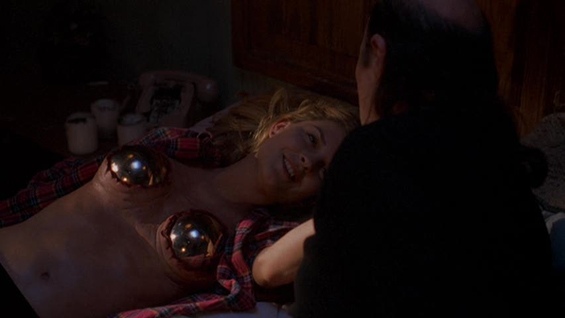
What Doesn’t Work: …a decreasing in importance of Reggie Bannister.
IV really is the true sequel to Phantasm, as the dynamics between Mike and Reggie here are more in line with what you would have expected from a sequel. Though Reggie still has vestiges of the awesome character that emerged in II, he feels out of sync here, and at times shoe-horned into the film. As much as I love Reggie Bannister, part of the problem is simply his performance. His reading of the narration that opens the film is incredibly cheesy, managing to de-cool great lines like, “My name is Reggie. I was an ice cream vendor by trade. Now… I’m a soldier.” Jokes likes Reg saying “Wow, some cops can be real assholes,” after dispatching the zombie cop just don’t land like they should. But Reggie’s performance is still great in as many scenes as it is lacking. That’s not the true problem. Coscarelli doesn’t feel as totally invested as he usually does. A lot of the Reg stuff feels like we’re going through the motions for no other reason except fan-service. Literally nothing that happens to Reg serves any greater consequence. Storywise, after the Tall Man releases Reg during the opening of the film, he could have never been seen again until showing up during the climax. Even then he doesn’t actually do anything. Coscarelli had rebooted the franchise with II, now Reggie was the pull. IV makes the bold move of rebooting things again, returning to Mike. Even overlooking the fact that Reggie is a more entertaining character than Mike, this leads to an inherent drawback…
If you don’t already know, the backstory on IV is this: 90’s notable Roger Avary (who has an Oscar because he helped Tarantino on the story for Pulp Fiction) dreamed up a massive Phantasm sequel. This project morphed into the much anticipated Phantasm’s End, which was to close out the series and co-star Bruce Campbell. When Coscarelli couldn’t find the money for that film, he conceived IV as a way to keep the franchise alive and drum up enthusiasm. IV was a placeholder, hopefully leading us into what would be the events of Phantasm’s End — although the sphere breasts image was pilfered from Avary’s script to use here. “And so it begins,” the Tall Man tells us. But as it turned out, this is where things ended instead.
The Phantasm franchise is such a grab-bag of ideas that there are a lot of different things for different people to glom onto. If you responded most to Mike’s tale in Phantasm and the surreal presentation of the story, if you hated that they replaced Baldwin with LeGros, then IV was probably a happy return to form and a perfect way to end the series. If you responded most to the revamped 80’s vibe of II, Reggie’s transformation, and the (somewhat) clearer presentation of ideas, then IV probably feels like a waste of time and terrible way to end the series. I can relate with both sentiments. The inherent drawback I speak of is the fact that Conscarelli switched things up on us twice in the span of four films, and didn’t give half the ‘phans’ something that would serve as a suitable conclusion. Basically, this second camp of phans had to sit through an existential Mike film, only to be teased in the last seconds with what constitutes saying, “And next up, the big Reggie action spectacular!” Whereas the weirdness generated by the place-holderness of IV, and it accidentally becoming the final film in the franchise, is what makes it work for the others.
While all the flashbacks and interweaving of backstory is fun, there isn’t much of a story in IV. Even if you don’t view this as a problem, it is hard to argue that – compared with the other films – it has much forward momentum. Other than the revelations about the Tall Man’s origins, nothing really happens. Everyone is just kinda hangin’ out, waiting for the movie to end so they can get onto Phantasm’s End. Mike spends a good portion of the movie building his own sphere, which turns out to be nothing more than a way to blow up his car to kill the Tall Man. Which doesn’t even kill the Tall Man. Why did Mike need to build some crazy device to blow up his car? He has telekinesis. And given all that we’ve seen, its not like a single member of the audience believed that a simple explosion was finally going to kill the unkillable Tall Man. IV has a few too many intriguing set ups chasing payoffs that either fizzle (such as that one) or don’t come at all. The Tall Man teases Mike the whole movie with “the end is nigh” cryptic one-liners, popping in and out of Mike’s scenes nonchalantly, no longer posing an actual threat to Mike. Soon, but not yet, he is saying. Yet when the “end” finally comes, it doesn’t actually feel like there was a specific moment the Tall Man was waiting for. The “end” comes because the movie is ending, not the other way around. That is the very definition of a stall or time-killer. Then there are a host of minor illogicalities, like why Mike runs away from Dr. Morningside instead of asking him questions — he doesn’t run away from the Tall Man himself anymore, what’s so terrifying about Morningside? Then later in the film Mike says he wishes he could go back to and try and change things. Uh, yeah, not shit dude. That’s like traveling back in time and meeting Hitler when he was a friendly painter, then inexplicably running away like a pussy for no reason. And then having the gall later on to say, “If only there were some way to go back in time and kill Hitler before he rose to power. If only.”
I think IV‘s shift towards the metaphysical was fitting, but I don’t like how that effected the portal fork. The portal became what I’d call a Whatever Device, meaning that it could do whatever the filmmaker wanted it to do and then never do it again if need be. Previously walking through the portal had only brought people to the Tall Man’s world. Now it can bring people through time, or to a peaceful beach (where Mike has a conversation with Jody). There is also a coffin in the back of the hearse through which the Tall Man can travel. Previously in the series the incomprehensible elements were always illogical or incomprehensible because of how the story was told, it felt like we were missing parts or simply that the idea only made marginal sense to begin with. The unfolding of Phantasm seemed to make sense to the characters. I have no idea why Mike’s female friend was suddenly exploring the mausoleum, but she seemed to. Thus the film felt like our nightmare, not theirs. That was its magic appeal. IV‘s bizarreness largely comes from things having no grounding in any reality, which I don’t think is as much fun.
This is a mere nitpick, but IV is also a casualty of its times, i.e. it features awful CG FX. From the brief bit of CG spheres we get in the film I am very happy that, a) the previous movies were made prior to the late 90’s, and b) there isn’t a lot of sphere action in IV.
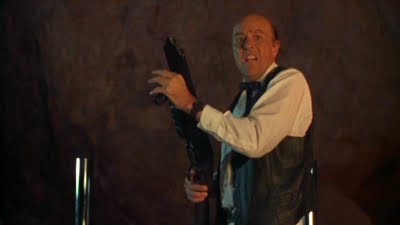
Best Sphere Kill: Not exactly a “kill,” but this nonetheless needs to go to the sphere breasts. Sphere. Breasts. Come on.
Best Tall Man Dialogue: To Mike, after Mike tries to commit suicide. “And no, you may not take your own life. That is my domain.”
Best Reggie Dialogue: Upon noticing that Jennifer’s breasts are throbbing. “Far out.”
Reggie Moment of Triumph: Reclaiming his ice cream man glory.
How Do Our Heroes Lose in the End: This is the only film in the franchise that doesn’t end with a character getting pulled through a window into a black void (can we truly call this a Phantasm film without that?). But Mike’s gambit to destroy the Tall Man totally fails and the Tall Man yanks the sphere out of Mike’s head, leaving him on the ground and exiting into the portal fork. Reggie, gun in hand and uniform on, follows the Tall Man through the portal.
Should The Franchise Have Ended Here: Fuck no! We needed Phantasm’s End goddammit!
Franchise Assessment: Of the many reasons why the Phantasm franchise is so effective, the top spot has to go to its ever evolving concepts. The Leprechaun series varied drastically from film to film, but those shifts constituted conceptual reboots, not evolution — new ideas where swapped in for older ones, instead building off them or expanding the franchise’s mythology. Phantasm wasn’t satisfied resting on its laurels, simply having Reggie battle spheres over and over again in slightly different ways. Coscarelli kept upping the ante and making things crazier and crazier. This is likely why the franchise never quite caught on in the main stream. It was just too much. The Tall Man may be iconic, but as a villain he is just as ambiguous as the films themselves. He lacked the simple hook a villain needs to appeal to teens hitting a movie at the mall. But therein lies his appeal to others. This franchise is just so weird it is hard to deny.
You can’t really blame a franchise for not being able to complete a planned installment it couldn’t get money for, and possibly this would have finally been addressed in Phantasm’s End (although from what I’ve heard, no), but I think the one big conceptual failing the franchise has is that we never journey into the Tall Man’s world. Maybe this story wouldn’t have worked at all, but the prominence that portal fork plays in each film makes the absence of its exploration conspicuous. And given the imagination Coscarelli displayed in the franchise, I have to assume it would have been intriguing madness. After all, of all the prominent horror franchises, Phantasm is arguably the most artistically provocative, beginning to end.
The franchise ranked from best to worst:
This franchise sorta defies being ranked from “best to worst,” because what criteria are we using? III feels the least original, because the other films are so extremely different from each other and III is just riffing on II, but we can’t forget all the crazy elements that film worked into the mythology — namely the Jody-sphere and the sphere in Mike’s head. IV is the least entertaining, but also the most overtly arty. II is a better made film than Phantasm, but does that mean it is better? And Phantasm is a genre landmark, but does that necessarily mean it is better than II? If we weigh together all the strengths and weaknesses of the films, for me it comes out as two sets of two-way ties.
Phantasm / Phantasm II
Phantasm III
Phantasm IV
Up Next: The Planet of the Apes franchise.
previous franchises battled
Leprechaun
Tremors
Critters
Death Wish
Police Academy